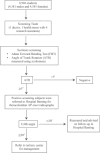The Clinical Effectiveness of School Screening Programme for Idiopathic Scoliosis in Malaysia
- PMID: 28435573
- PMCID: PMC5393113
- DOI: 10.5704/MOJ.1703.018
The Clinical Effectiveness of School Screening Programme for Idiopathic Scoliosis in Malaysia
Abstract
Introduction: There is no large population size study on school screening for scoliosis in Malaysia. This study is aimed to determine the prevalence rate and positive predictive value (PPV) of screening programme for adolescent idiopathic scoliosis.
Materials and methods: A total of 8966 voluntary school students aged 13-15 years old were recruited for scoliosis screening. Screening was done by measuring the angle of trunk rotation (ATR) on forward bending test (FBT) using a scoliometer. ATR of 5 degrees or more was considered positive. Positively screened students had standard radiographs done for measurement of the Cobb angle. Cobb angle of >10° was used to diagnose scoliosis. The percentage of radiological assessment referral, prevalence rate and PPV of scoliosis were then calculated.
Results: Percentage of radiological assessment referral (ATR >5°) was 4.2% (182/4381) for male and 5.0% (228/4585) for female. Only 38.0% of those with ATR >5° presented for further radiological assessment. The adjusted prevalence rate was 2.55% for Cobb angle >10°, 0.59% for >20° and 0.12% for >40°. The PPV is 55.8% for Cobb angle >10°, 12.8% for >20° and 2.6% for > 40°.
Conclusions: This is the largest study of school scoliosis screening in Malaysia. The prevalence rate of scoliosis was 2.55%. The positive predictive value was 55.8%, which is adequate to suggest that the school scoliosis screening programme did play a role in early detection of scoliosis. However, a cost effectiveness analysis will be needed to firmly determine its efficacy.
Keywords: adolescent idiopathic scoliosis; positive predictive value; prevalence; school screening.
Figures
Similar articles
-
Prevalence Rate of Adolescent Idiopathic Scoliosis: Results of School-based Screening in Surabaya, Indonesia.Malays Orthop J. 2017 Nov;11(3):17-22. doi: 10.5704/MOJ.1711.011. Malays Orthop J. 2017. PMID: 29326761 Free PMC article.
-
Cut-off point of the Scoliometer in school scoliosis screening.Spine (Phila Pa 1976). 1997 Sep 1;22(17):1985-9. doi: 10.1097/00007632-199709010-00007. Spine (Phila Pa 1976). 1997. PMID: 9306527
-
Ten-year follow-up evaluation of a school screening program for scoliosis. Is the forward-bending test an accurate diagnostic criterion for the screening of scoliosis?Spine (Phila Pa 1976). 1999 Nov 15;24(22):2318-24. doi: 10.1097/00007632-199911150-00006. Spine (Phila Pa 1976). 1999. PMID: 10586455
-
A meta-analysis of the clinical effectiveness of school scoliosis screening.Spine (Phila Pa 1976). 2010 May 1;35(10):1061-71. doi: 10.1097/BRS.0b013e3181bcc835. Spine (Phila Pa 1976). 2010. PMID: 20393399 Review.
-
Systematic Review of School Scoliosis Screening.Spine Deform. 2017 Sep;5(5):303-309. doi: 10.1016/j.jspd.2017.03.009. Spine Deform. 2017. PMID: 28882347
Cited by
-
Screening for adolescent idiopathic scoliosis is more accurate when performed by healthcare professionals compared to untrained parents: a diagnostic accuracy study.Eur Spine J. 2022 Sep;31(9):2339-2347. doi: 10.1007/s00586-022-07115-z. Epub 2022 Apr 7. Eur Spine J. 2022. PMID: 35389103
-
Ethnic Disparity in the Incidence of Scoliosis Among Adolescents in Tianzhu Tibetan Autonomous County, China.Front Public Health. 2022 Apr 27;10:791550. doi: 10.3389/fpubh.2022.791550. eCollection 2022. Front Public Health. 2022. PMID: 35570980 Free PMC article.
-
To Screen or Not to Screen: "False Positive" Cases-Can They Be Treated as Definitely False? Properly Selecting the Screening Age-Range Groups in Scoliosis Screening Programs.Healthcare (Basel). 2025 Mar 10;13(6):600. doi: 10.3390/healthcare13060600. Healthcare (Basel). 2025. PMID: 40150450 Free PMC article.
-
Prevalence Rate of Adolescent Idiopathic Scoliosis: Results of School-based Screening in Surabaya, Indonesia.Malays Orthop J. 2017 Nov;11(3):17-22. doi: 10.5704/MOJ.1711.011. Malays Orthop J. 2017. PMID: 29326761 Free PMC article.
-
Handgrip strength assessment at baseline in addition to bone parameters could potentially predict the risk of curve progression in adolescent idiopathic scoliosis.Front Pediatr. 2023 Nov 3;11:1258454. doi: 10.3389/fped.2023.1258454. eCollection 2023. Front Pediatr. 2023. PMID: 38027290 Free PMC article.
References
-
- Wong HK, Hui JH, Rajan U, Chia HP. Idiopathic scoliosis in Singapore schoolchildren: a prevalence study 15 years into the screening program. Spine. 2005;30(10):1188–1196. - PubMed
-
- Yong F, Wong HK, Chow KY. Prevalence of adolescent idiopathic scoliosis among female school children in Singapore. Ann Acad Med Singapore. 2009;38(12):1056–1063. - PubMed
-
- Luk KD, Lee CF, Cheung KM, Cheng JC, Ng BK, Lam TP, et al. Clinical effectiveness of school screening for adolescent idiopathic scoliosis: a large population-based retrospective cohort study. Spine. 2010;35(17):1607–1614. - PubMed
-
- Ueno M, Takaso M, Nakazawa T, Imura T, Saito W, Shintani R, et al. A 5-year epidemiological study on the prevalence rate of idiopathic scoliosis in Tokyo: school screening of more than 250,000 children. J Orthop Sci. 2011;16(1):1–6. - PubMed
LinkOut - more resources
Full Text Sources
Other Literature Sources
Miscellaneous

